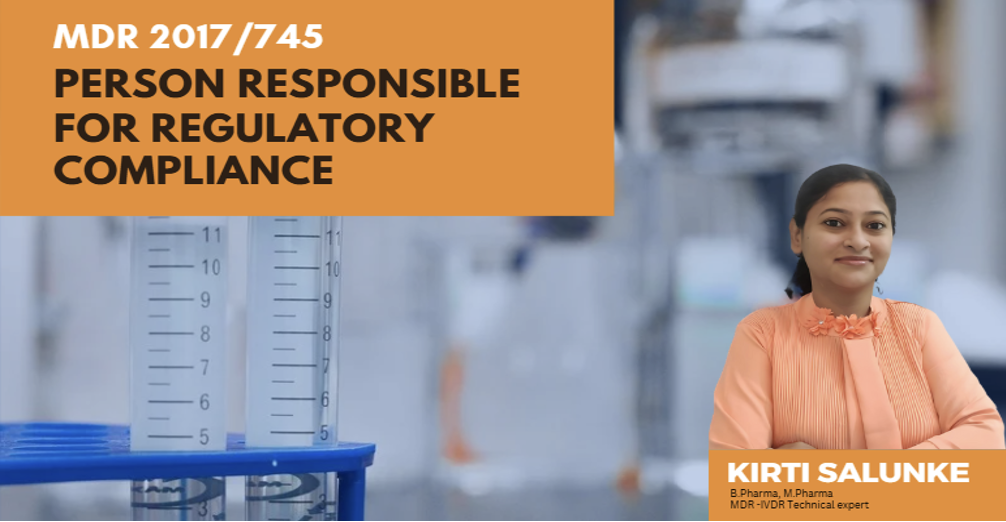Embracing the role of PRRC is not just a regulatory requirement—it’s a commitment to excellence in healthcare delivery.
In the intricate world of medical device regulations, the European Union’s Medical Device Regulation (EU MDR 2017/745) and In Vitro Diagnostic Regulation (IVDR 2017/746) stand as a bulwark to ensure safety, efficacy, and accountability. Among the pivotal elements of these frameworks is the role of the Person Responsible for Regulatory Compliance (PRRC), a key figure mandated under Article 15 of both regulations.
Without a PRRC, a manufacturer may face delays or denials in obtaining CE markings, hindering the ability to market products within the EU. Some EU member states have established penalties for non-compliance with MDR/IVDR requirements. For instance, Italy has implemented fines ranging from €20,000 to over €150,000 for various infringements related to the MDR. Non-compliance may lead to product withdrawals or recalls, preventing manufacturers from selling their devices in the EU market.
Addressing the root causes of these denials is crucial to overcome obstacles effectively. Technical and scientific expert Kirti Salunke from I3CGlobal highlights key provisions of Article 15 of these regulations, that mandate the appointment of a “Person Responsible for Regulatory Compliance” (PRRC). The PRRC is not only a compliance figurehead but also a strategic partner in ensuring product integrity and facilitating market access.
Compliance Requirements for PRRC
1. For Large Manufacturers, as outlined in Article 15(1) and elaborated by MDCG Guidance 2019-7, large manufacturers—employing over 50 people with an annual turnover exceeding €10 million—must appoint an in-house PRRC. For conglomerates with multiple legal manufacturers, each must individually designate a PRRC to maintain regulatory compliance.
2. Micro and Small Manufacturers that employ fewer than 50 persons and whose annual turnover and/or annual balance sheet total does not exceed EUR 10 million, the PRRC are required to be “permanently and continuously at their disposal” rather than “within their organisation. Therefore, manufacturers are permitted to designate an external subcontractor as their PRRC. In these cases, PRRC may be part of an external organisation with which the manufacturer has established a contract laying down provisions to ensure permanent and continuous availability of that party.
3. Systems or procedure packs Producers who put devices together into systems or procedure packs using devices that do not already bear the CE marking, where the combination of devices is not compatible with their original intended purpose, or where sterilization has not been performed following the manufacturer’s instructions, fall under Article 22 (4). Such systems and procedure packs are treated as medical devices in their own right; therefore, such organisations assume the obligations incumbent on manufacturers and are required to designate a PRRC.
4. Importers, distributors, and other persons acting as manufacturers that market devices under their name or modify products to impact compliance must appoint a PRRC.
5. Authorized representatives in the EU are mandated to ensure continuous regulatory presence by having a qualified PRRC at their disposal.
Qualifications of the PRRC
· An educational background that includes a degree in law, medicine, pharmacy, engineering, or another relevant scientific discipline.
· Professional Experience with at least one year in regulatory affairs or quality management systems specifically related to medical devices, ensuring they possess the expertise necessary for effective compliance management or at least four years of professional experience in relevant fields.
· Non-EU credentials must be certified equivalent by EU member states, utilizing platforms such as ENIC and NARIC for validation.
Responsibilities of the PRRC
· Ensuring device conformity with Medical Device and IVDR regulation standards for regulatory compliance before market release.
· Ensuring that technical documentation is meticulously prepared, maintained, and updated as per Annexes II and III of the EU MDR/IVDR.
· Monitoring the post-market performance and safety of devices through systematic vigilance activities, ensuring ongoing compliance with safety standards, and identifying potential risks.
· Ensuring that serious incidents and field safety corrective actions are reported to the competent authorities, maintaining transparency and compliance with EU MDR/IVDR requirements.
· Verifying EU declaration of conformity is appropriately drafted and maintained, ensuring its accuracy and adherence to regulatory requirements.
· For investigational devices or devices intended for performance studies in IVDs, the PRRC ensures that a signed statement is provided by the natural or legal person responsible for manufacturing the investigational device or conducting the performance study. This statement must confirm that the device complies with general safety and performance requirements, except for aspects covered by the clinical investigation or performance study, and that all necessary precautions have been taken to safeguard the health and safety of the subjects involved.
Conclusion
The Person Responsible for Regulatory Compliance plays a critical role in ensuring the safety, quality, and regulatory compliance of medical devices in the EU market. Manufacturers must prioritize the appointment of a qualified PRRC to avoid regulatory pitfalls. The PRRC is a regulatory formality—it’s a cornerstone of accountability. By anchoring regulatory expertise within or closely tied to organizations, the PRRC ensures that manufacturers uphold the EU’s high standards for medical devices. This role protects patient safety and bolsters public trust in an industry pivotal to global health.




